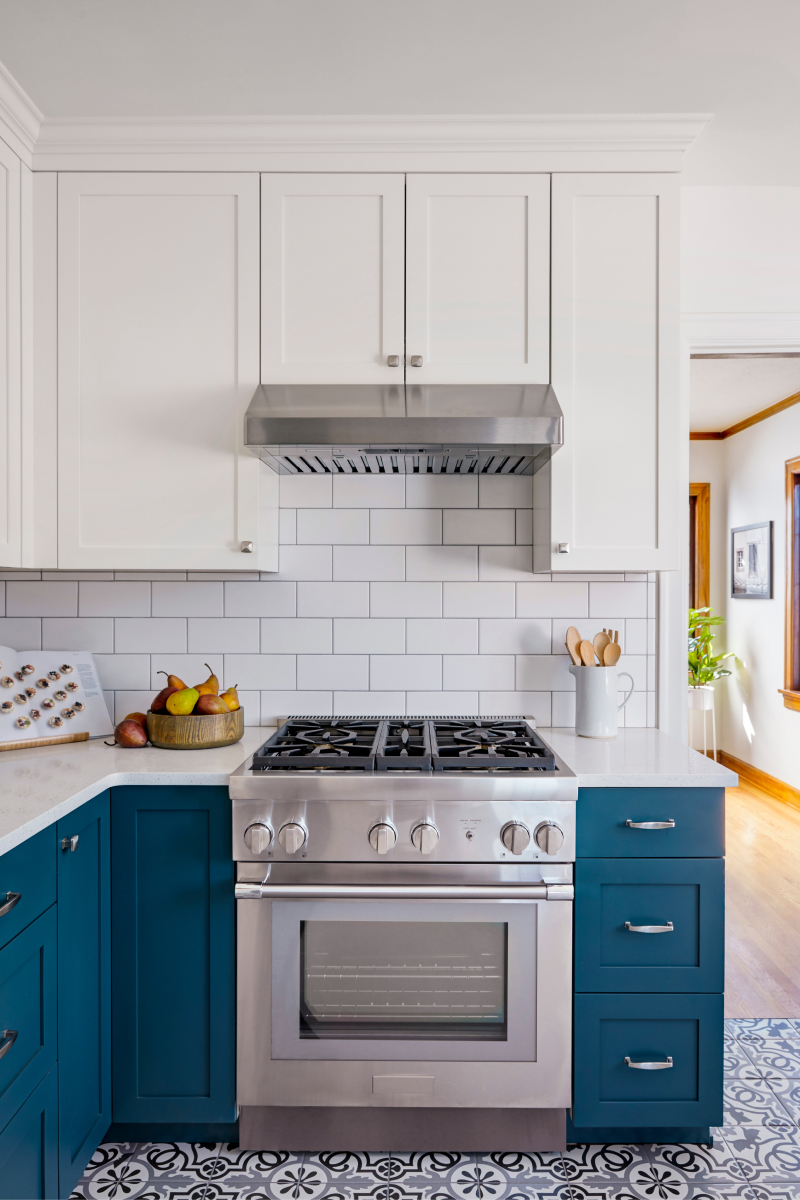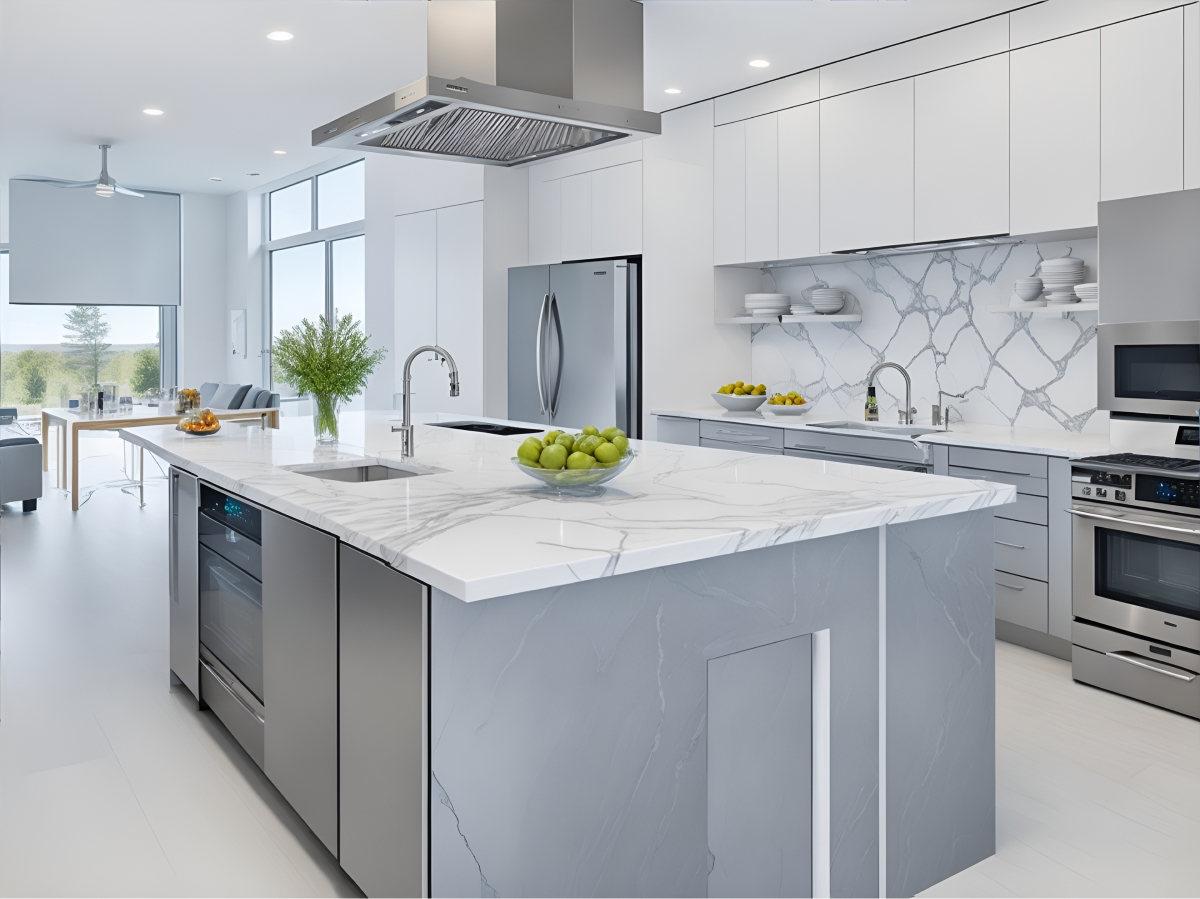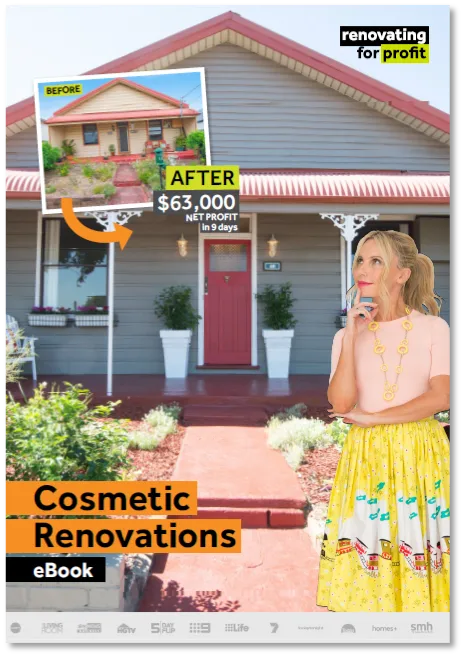Kitchen Cabinets: To Brighten Up or Darken Down?
G’day, fellow renovators!
Contemplating a kitchen reno in the not-too-distant future? It doesn’t matter if you’re embarking on a full-on, gut & start again kitchen renovation or just giving your existing one, a fresh lick of cabinetry paint, deciding on the colours for your upper & lower kitchen cabinetry can be as tricky as deciding between Anzac biscuits or Tim Tams. But fret not! I’m here to help you navigate the vibrant world of kitchen colours with some general rules, do’s and don’ts & a special focus on two-toned cabinets, something many Aussies love to do.

1. FIRST DECIDE IF YOU SHOULD GO LIGHT OR DARK COLOURS
First up, try and determine if you feel more comfortable keeping everything on the lighter side or whether you’re bold and adventurous enough to sway towards the dark side. Keep the following in mind:
Light Colours Make Spaces Look Bigger
If your kitchen is more “cosy” than “catwalk,” (meaning it’s on the smaller side), opting for lighter colours will definitely make your room feel more open. Light colours reflect more light, both naturally and artificially, making spaces appear brighter and therefore more open.

Lighter colours are also great for seamlessly blending in with walls and ceilings, creating a continuous flow that can make room boundaries less noticeable and therefore make rooms feel less cramped. Whites, creams & soft pastels are great colours that can reflect light and therefore, create the illusion of a larger area.
Of other importance is the psychological effect of colour. Light colours are often associated with cleanliness and spaciousness. They can trick the eye into perceiving your room is larger than what it actually is.

Dark Colours Add Depth & Drama
For those with a bit more space to play with, darker colours like navy’s, charcoals, black & deep greens can add a sense of sophistication and depth. This is achieved through contrast and balance where dark cabinetry creates a strong contrast with lighter walls, benchtops and flooring. This creates layers & a delineation of the different areas and surfaces which adds to the perception of depth in your room.

Dark cabinetry also serves as a focal point, drawing your eye into a room whilst also naturally casting shadows and highlights. The interplay of light and shadow can enhance the three-dimensionality of any space.
More importantly, dark cabinetry works wonders for making walls appear like they’re receding out, creating the illusion of a larger space. This optical trick can make a room feel more spacious and open; however, if you’re loving the thought of darker cabinets, you will need to pay careful attention to lighting and complementary colours used throughout the rest of the room to ensure the space remains well-lit and balanced. Failing to get your lighting and colours right and your kitchen risks feeling too dim and therefore, enclosed in.

So, before we move off this point, here’s my best advice – if your kitchen is on the smaller side, stick with lighter colours. If you’ve got room to play with but you’re more the conservative type, still stick with lighter colours. If you’ve got room to play with and you swing to the adventurous side, give darker cabinetry colours a go.

2. CONSIDER THE DO’S & DON’TS OF KITCHEN CABINET COLOURS
Do’s:
-
Do Consider Your Kitchen’s Natural Light
A kitchen bathed in sunlight can handle darker shades without feeling like a dungeon. If your kitchen is on the darker side, stick to lighter tones to keep things bright and airy.
-
Do Think About Your Overall Theme
Are you going for a sleek, modern look or a rustic, farmhouse vibe? Your cabinet colours should complement the overall theme. For example, a coastal theme might call for crisp whites and blues, while an industrial look might favour greys and blacks.
-
Do Use Accent Colours Wisely
A pop of colour can add personality to your kitchen. Whether it’s a bold island bench or a vibrant backsplash, accents can bring personality to your kitchen, making it feel less boring.

Don’ts:
-
Don’t Ignore the Rest of Your Home
Your kitchen shouldn’t feel like it’s in a different postcode from the rest of your house. Ensure your colour choices harmonise with your adjoining rooms for a cohesive look.
-
Don’t Go Too Trendy
Remember that avocado green and harvest gold cabinets were once all the rage. Trendy colours can date your kitchen quickly. Opt for timeless shades and add trendy accents that are easier to update.
-
Don’t Forget Maintenance
Light colours show dirt and grime more easily, while dark colours can show dust and fingerprints. Consider your cleaning preferences when making your choice. If you’re not keen on constant cleaning, a mid-tone might be your best bet.
-
Don’t Overwhelm with Colour
Too many colours can make your kitchen look like a crayon box exploded. Stick to two main colours and one or two accent colours to keep things harmonious. This leads me to my next section – one cabinet colour or two-toned cabinets?

3. TWO-TONED KITCHEN CABINETRY: THE PERFECT BALANCE
Still can’t decide if you want to go light or dark? Two-toned kitchen cabinets may be the answer you’re looking for. By combining two complementary or contrasting colours, you can create a dynamic and visually appealing kitchen, in effect, giving you the best of both worlds. Here’s what you need to know:
- One of the easiest ways to approach two-toned cabinets is to use a light colour for your upper wall cabinets and a darker shade for your base floor cabinets. This combination keeps your kitchen feeling open and airy while grounding the space with a darker base.
- Avoid using dark colours on your upper wall cabinets with lighter colours on your base cabinets. Doing so will make your kitchen feel top-heavy and unbalanced, making your space feel smaller and therefore, more closed-in. This will be an issue for small kitchens where maintaining an open and airy feel is super important.

- Know that natural light enters windows in your kitchen horizontally, resulting in your upper wall cabinets receiving less natural light than your base cabinets. Hard to believe but true! Dark colours on your upper cabinets can absorb light, reducing the overall brightness of your kitchen, making it feel more cramped.
- Consider the layout and flow of your kitchen. Two-toned cabinets can be great for delineating different areas such as separating the cooking zone from the dining area, enhancing how functional your kitchen actually becomes.
- Apply the principles of colour theory (refer to a thing called “the colour wheel”) to choose complementary or contrasting colours that harmonise well and enhance the overall aesthetic of your kitchen.
- Assess the materials you’re planning to use for your cabinetry. Different materials reflect light differently and mixing finishes (e.g. matte and gloss) can add depth and interest.
- Remember, upper cabinets are naturally more prone to collecting dust and grease than your base cabinets. Dark colours can make these issues more visible and harder to maintain a clean appearance.
- Ensure your cabinet hardware such as your handles or knobs, complement both cabinetry colours. Finishes such as chrome or mixed metals often work well across two-toned cabinetry.
- Take into account any existing or new architectural features you want to add into your kitchen like the tile splashback in between your base & upper cabinets. If you’re selecting an out there tile for your splashback, balance it out with one single cabinetry colour, not two.
- Analyse the cost implications. Two-toned cabinetry may be more expensive to purchase than single-tone cabinets, especially if using premium finishes or materials. Your cabinetmaker will be able to advise you on this.
- Consider the long-term flexibility of your colour choices. Two-toned cabinets can offer a timeless look if neutral tones are chosen, but bolder choices might require updates as trends evolve.
- Don’t be scared to embrace colour. Maybe a splash of deep blue or emerald green on your lower cabinets while keeping the uppers a classic white. The key is to inject personality into your kitchen without overwhelming the space.

THE FINAL SAY
Some of you might say, “Just go all white cabinets!”. Well, white cabinets are like the vegemite of kitchen designs – you either love them or you don’t. They’re classic, versatile, and can match almost anything. But remember, just like vegemite, a little goes a long way. Too much white & you risk your kitchen looking clinical.
I always think the safest way to go is to balance lighter colours out by incorporating other colours or textures into your kitchen design (such as warm woods) so your kitchen doesn’t end up looking bland. This is successfully done with two toned cabinetry which is very popular in most kitchen designs today.

TESTING, TESTING, TESTING
Before you commit to your cabinetry colours, remember that even kangaroos test their footing before they hop. Grab yourself one or more paint sample pots from your local Bunnings store and paint a large swatch of paint on your existing cabinets and live with it for a few days. You’ll get a better feel for how the colour interacts with the light and all your other kitchen elements, specific to your home.
THE WRAP UP
Without a doubt, choosing colours for your kitchen cabinetry is a bit like navigating the great Australian outback – it’s an adventure filled with possibilities!
When it comes to choosing your kitchen cabinet colours, remember that the heart of your home is your kitchen and this room should make you happy. After all, you will be spending a fair bit of time there – cooking, eating, and of course, dodging the occasional spider.
Whether you lean towards light, bright spaces or moody, dramatic hues, the key is to find a balance that reflects your style, feels right for you and your lifestyle. Remember the general rules, heed the dos and don’ts, and most importantly, have a bit of fun with it.

If you’re going to be renovating your kitchen and want to get seriously clued up on everything you need to know before you start, be sure to check out my Create Your Perfect Kitchen Course.
Happy renovating friends!
Much love,
Cherie x





Real nice design and superb written content, absolutely nothing else we need : D.
https://www.droversointeru.com